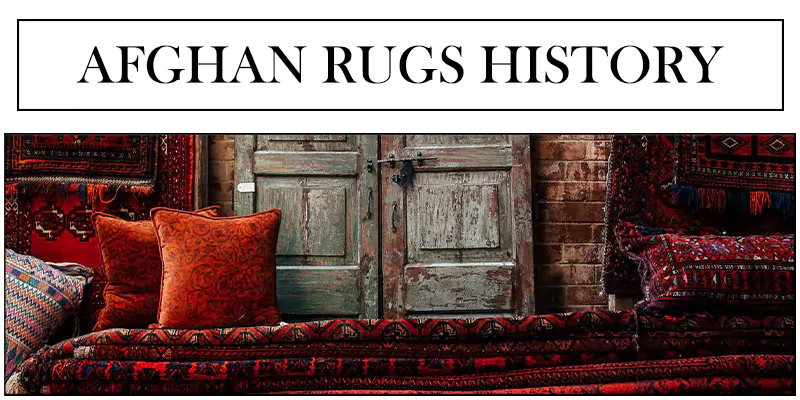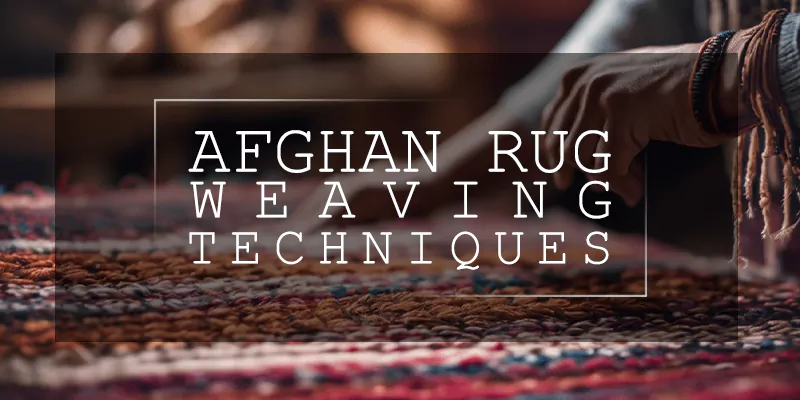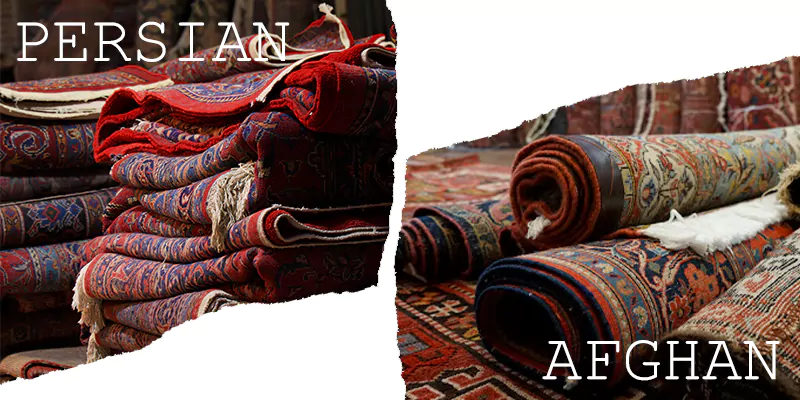- Abe
- Rug & Carpet
- 513 views
- 0 comments
An Afghan rug is not just a floor cover; it is a history crested into the fiber of the Afghan culture. Afghan rugs and carpets are famous for their complicated patterns and slipping ability that has been an important representation of the Afghan culture all through the ages as both utility products as well as masterpiece creative skills.
It can hardly be imagined that the production of such intricate items is as elaborate as their ornamentation, proving that this craft has been inherited from prior generations.
To be more precise, by reading this article, you will be acquainted with the historical basis of Afghan rugs and, therefore, understand how these exquisite items developed. You will also learn about the production process of Afghan carpets and unlink the meaning of the most frequently used motives; learn the differences and similarities between Afghan and Persian carpet.

Historical Background of Afghan Rugs
Afghan carpet weaving and its significance occupies a prestigious niche in the country’s tradition and is influenced by such neighbors as Iran.
It is estimated that the rug making has a long history in Afghanistan even in the early sixteenth century where they served multiple practical uses in households and as well art pieces. These finest Afghan rugs and carpets were created during the reign of King Amanullah Khan in the early twentieth century, the workmanship is apparent with designs considered to be some of the most complex to this date.
The geographical location of Afghanistan in particular as the connector between Europe Asia and the Middle East has greatly contributed to the country’s culture well reflected in Afghan rugs designs. These rugs are designed with factors derived from the Kazak, Turkmen, and Mahal arts the result is an efficient mix.
The conflicts and the wars that characterized the history of the area also influenced the appearance of the rugs: in addition to the geometrical motives common to most contemporary collectible models, many existing rugs bear clear military references. Thus, combining art and history in Afghan rugs speaks not only of the beauty of these vintage carpets but also of the narrative of a nation and its multicultural legacy.
Cyrus Crafts; Luxury & Unique Products
Afghan Rugs Materials
Afghan rugs are mainly made from wool, which is well known to be very hardwearing and insulating. The wool that has been used in the production of the fabric is locally sourced and the fiber obtained is from sheep, the matured wool is then washed to ensure that it is pure from impurities before being dyed.
The wearers now get the wool dyed with bright and permanent natural colors from plants, animals, and even insects. It ensures that the dyes used are eco-friendly, and as a result, it enriches the colors while making the method of making the rugs environmentally friendly.

Afghan Rugs Weaving Techniques
Afghan area rugs take time to produce and can take a few months to over a year depending on the design and size of the carpet to be made. Technicians continue to follow traditional approaches and Persian and Turkish patterns are created a density per square inch of knots is denoted by KPSI.
KPSI relates to the level of detail on a rug where the higher setting of KPSI produces a rug with finer details. This is more apparent in designs made with the cultural practices of the artisans’ tribe in mind, as these patterns will denote certain history or practices.
Afghan Rug Designs
Afghan rugs showcase a variety of patterns deeply rooted in the country's cultural history. The most prevalent design is the "Afghan Bokkara," characterized by the “gul motif”, a large, quartered octagon also known as the "elephant's foot." Afghan rug motifs, typically displayed in rows or columns, are framed within intricate borders. Another traditional design includes the Khal Mohammadi, known for its deep reds and dark tones, featuring stylized floral patterns and octagonal stars, predominantly knotted by Afghans in the northern regions.
Afghan Rug Regional Variations
The art of rug making varies significantly across Afghanistan, with notable influences from the nomadic tribes and regional artisans. In regions like Kabul, Herat, and Kandahar, carpet knotting takes on distinct characteristics. For example, Balouch rugs that originate from these areas use geometric design and are characterized by prayer rug sizes and mostly come in colors such as brown, grey, and rusty colored. Furthermore, the contemporary Afghan war rugs are a sad commentary on the Afghan situation and depict camouflages and weapons in their fabric design which symbolize the state of the Afghan nation.

Afghan Rugs Vs. Persian Rugs
An effective way to compare the two is to have a look at their background and factors that define Afghan and Persian rugs separately. Persian refers to the rugs which are created in the Persian region, in present-day Iran, and are luxury rugs made from silk and wool. Often, these rugs employ the designs of various flowers, a central round emblem or medallion the refined arabesque of the corner and side borders and all are imbued with the cultural significance of places where Tabriz rugs and Isfahan rugs are made. The interweaving of the Persian rugs also uses asymmetrical knots, and this feature enables beautiful and complicated patterns to be incorporated into the rugs, and this explains why they are associated with elegance and luxury.
Afghan rugs’ designs remain conditioned by the tribal art that is characterized by geometrical shapes and rough color ranges that mimic the natural environment. Often these rugs use symmetrical that is Turkish rug knots, which hold the fibers tightly to give the carpet sturdiness.
Both of them are wonderful to have for home decoration as they have cultural values, expressing the heritage of those countries who made them. While Persian rugs are considered as luxurious floor coverings and art, the Afghani rugs have higher durability and the history of the Afghan people and its nomadic culture.
Popular Afghan Rug Patterns
The following are two of the most popular patterns of Afghan rugs you can find in the market, and we have explained each one briefly in the following:
Khal Mohammadi
Some of the Keshan district rugs are Khal Mohammadi which are carpets woven with Khal Mohammad patterns and characterized by strong structure and bright dyes. The matured color palette commonly used within these rugs is deep red, dark blue, and brown originating from the madder root and walnut husk dyes.
The featured designs usually create repetitive geometric designs; the symbols realized by a superb skill in carving; floral designs, are mainly stylized; and the overall design of a piece depicting natural features, such as a symmetrical medallion. The wool utilized is from Afghan sheep that is purchased locally, it is hard-wearing and gives the rug a lustrous feel.
Baluchi Rugs
Baluchi Revival rugs are synonymous with dark, rich colors, rectilinear geometric forms, distinctive pear-shaped medallions, and geometric forms with a strong focus on hexagons and rectangles. Kashmir and the Baluch region weavers exclusively use natural materials such as wool, and cotton sometimes mixed with goat and sort of camel hair to make the rug tough and more textured.
These rugs are normally made with balanced asymmetric knots and can take as long as ten months to be produced and they reflect the art of the Baluchi tribes. Natural dyes give rich and clean colors to rugs thus guaranteeing the beauty and elegance of each of the natural rugs.
Afghan Rugs FAQs
These are some of the most common Frequently Asked Questions about Afghanistan rugs on the Internet and we have answered all of them in detail.
What is the origin and historical significance of Afghan carpets?
Afghan carpets boast a rich heritage, tracing their origins back to the 16th century. Initially, these carpets served both decorative and practical purposes, beautifying homes and providing warmth during harsh winters.
What distinct features define Afghan rugs?
Afghan rugs are primarily characterized by their rich, dark red tones and traditional knotting techniques. Their designs commonly feature the Gul or Göl motif, which consists of an octagonal row pattern, and stars that are also octagonal in shape.
What do Afghan war rugs represent?
Afghan war rugs are a modern category of oriental carpets that reflect the evolving consciousness of the local populace, who are among the poorest in the world. These rugs have emerged amidst the region's exposure to global influences and conflicts.
How can one verify the authenticity of an Afghan rug?
To determine if an Afghan rug is authentic, examine the rug’s fringes and selvedges (edges). Genuine Afghan rugs typically have short, knotted fringes, as opposed to the long, tasseled fringes or glued-on fringes found on machine-made rugs.









Comments (0)